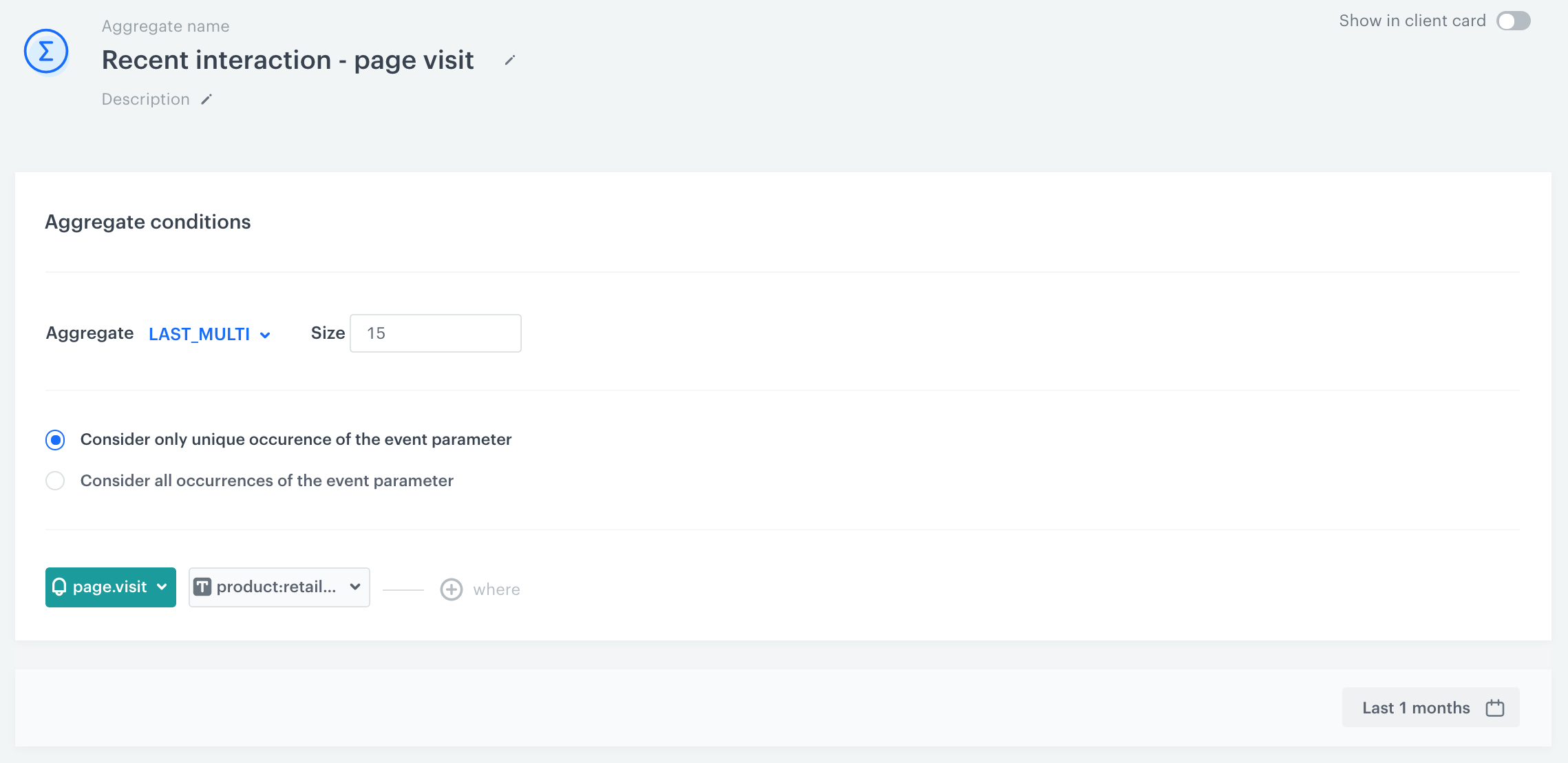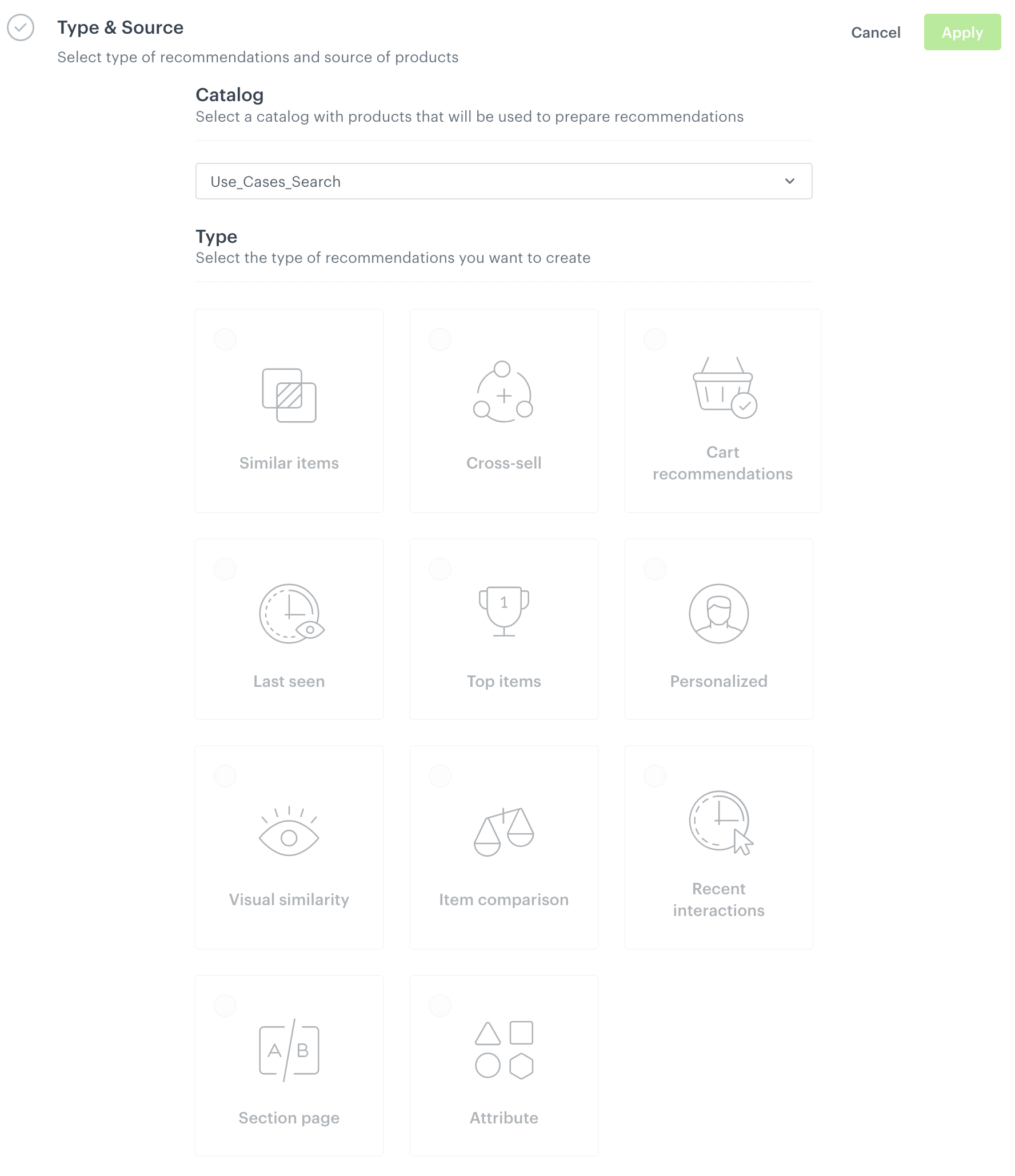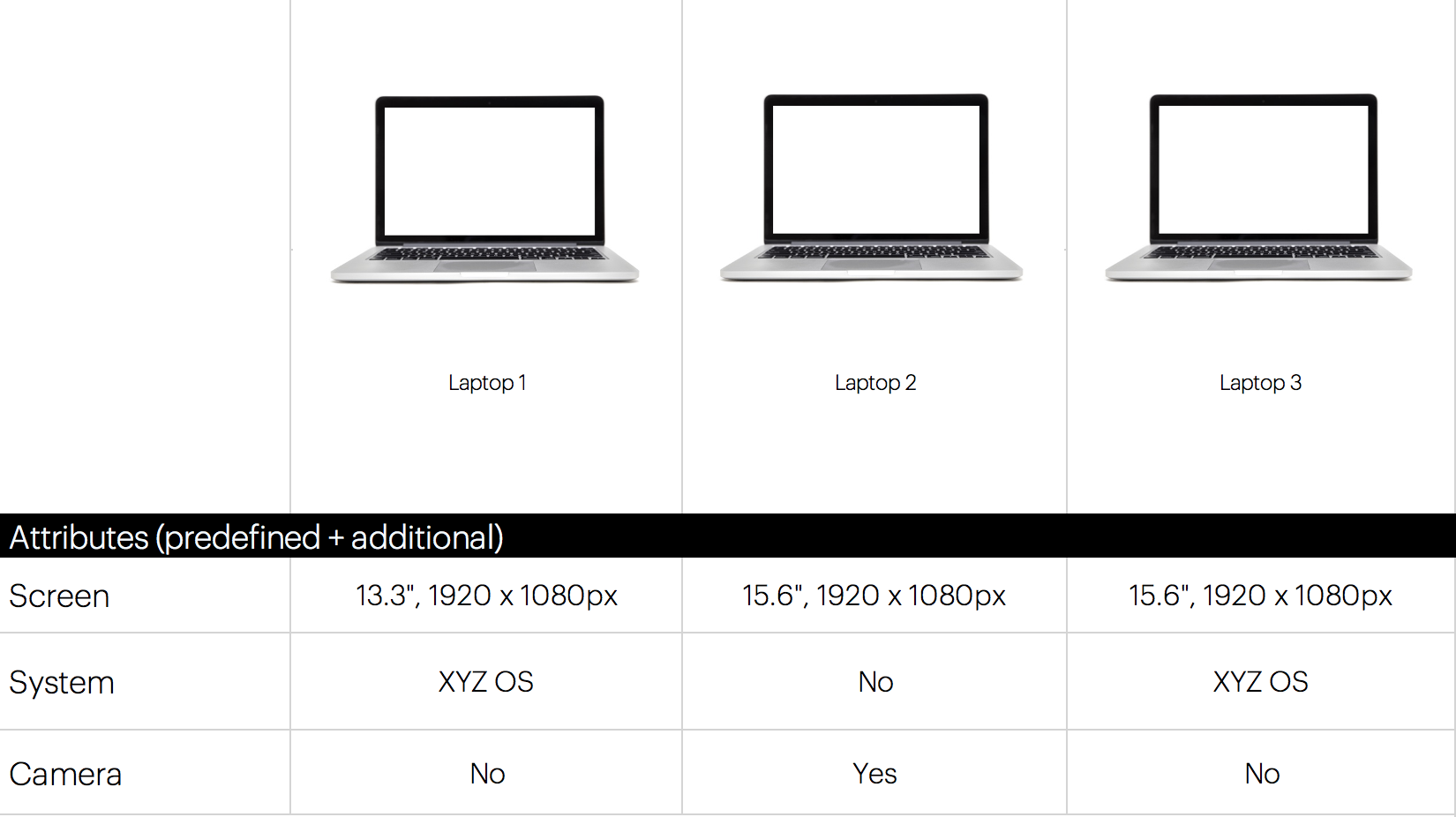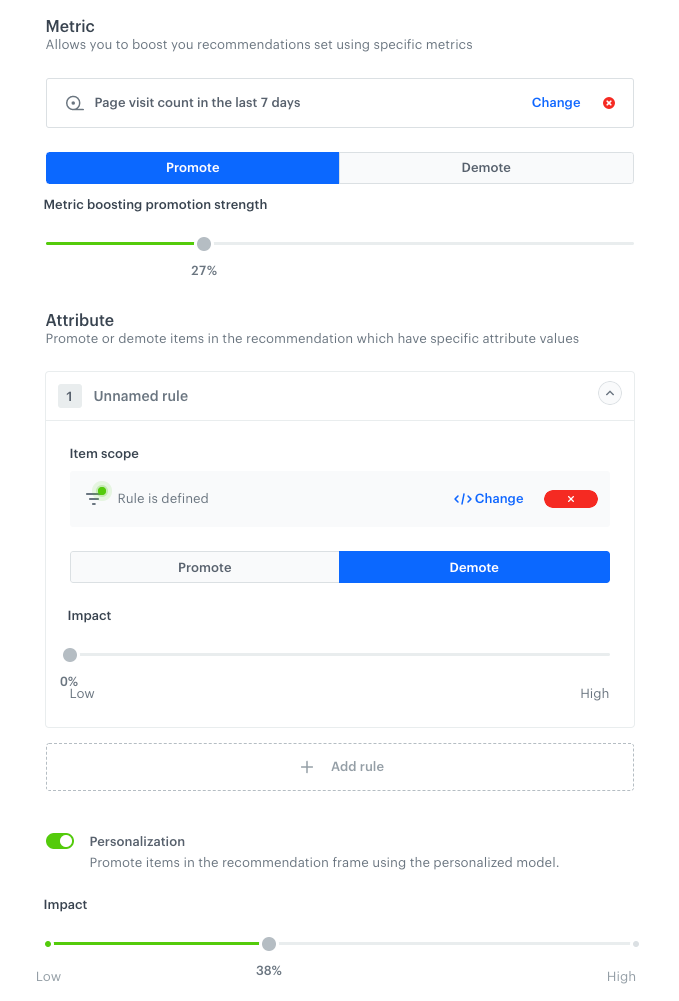Creating recommendations
Once the model training is completed, you can create a recommendation. The recommendations you create and activate will not be visible until you indicate how and where the recommendations are to be displayed.
Because each recommendation is different for every customer, you can’t indicate exactly the items to be shown in the recommendations. However, you can preview the recommendation for any customer.
Distributing recommendations
You can use the ID of the recommendation and insert it in other types of communication, such as:
- dynamic content - this way you can show the recommendations on your website.
- email - this way you can send out recommended items through emails.
- mobile application - you can use documents to build your own mobile app and show the recommended items.
- mobile push - you can send recommendations through notifications in your mobile application.
- web push - this way you can send notifications to your customers through a web browser.
- SMS - this way you can reach your customers with recommendations on their mobile.
You may want to read
- Recommendation types
- How to build a filter in a recommendation
- Filters - examples of use
- Previewing recommendations
- Recommendation statistics
Prerequisites
- You must configure an item catalog for recommendations.
- You must have permissions from the following sets:
- Communications > Recommendations
Without these permissions, you can’t see the Recommendations module in the menu. - Assets > Catalogs
Without these permissions, the Recommendations module may not load.
- Communications > Recommendations
- If you want to create the Recent interactions recommendation, create an aggregate that gathers a group of items towards which a specific event has occurred
Click here to see example aggregate

The Type & Source section Required in the configuration:
- Aggregate type set as Last Multi
- Event
- Event parameter connected to an item
Note: You can read more about aggregates here.
Creating recommendation
- Go to
 Communication > Recommendations > Add recommendation.
Communication > Recommendations > Add recommendation. - Enter the name of the recommendation (it is only visible on the list of recommendation).
Select feed and recommendation type
Start with selecting the feed from which items will be sourced to recommendations and the type of recommendations to be displayed.

- In the Type & source section, click Define.
- From the Catalog dropdown list, select an item feed.
- Below, select the recommendation type.
If the recommendations are greyed out, it means the AI engine is not trained yet or that a recommendation type is not available for the particular catalog. - Confirm the settings by clicking Apply.
Select an aggregate (only recent interactions model)

- Select the aggregate you created within the scope of Prerequisites
- Confirm the selection by clicking Apply.
- Proceed to Configuring comparison attributes.
Configure comparison attributes (only item comparison model)

You can select the attributes of the items to be included in the comparison. The attributes in the Predefined attributes section are sourced from the Response attributes which can be edited in Settings > AI Engine Configuration.
- To add more attributes apart from the predefined ones to the comparison, in the Additional attributes, click Select attributes.
- On the pop-up, select the attributes.
- Confirm by clicking Apply.
Result: Example item comparison on a website (the context item is included in one of the columns):
Example item comparison frame
Configure item slots
You can use slots to assign space in your recommendation frame to specific items. Each slot may include a different number of items and have its own filtering rules.

For example, you can use three slots to display:
- Items of specific brand - This allows you to use space in your recommendation slots by items of your partners and suppliers.
- Items of specific category,
- Items of specific color
A recommendation must include at least one slot.
- In the Items section, click Define.
- If you’re adding more than one slot and want to define the order in which items will be displayed, toggle the Keep items in slot order option.
- When the option is disabled, the items will be arranged according to specified ordering metric (model score by default).
- When this option is enabled, the items will be returned in the order of the slots, defined in the recommendation campaign creator. The items will be sorted by the specified ordering metric (model score by default) but within the defined slots.
Adding slots
- Click Add slot.
- If you want to name the slot, hover over Unnamed slot bar and click the pencil icon which appears at the right side of the bar.
- Click the created slot to expand its settings.
- Enter the minimum and maximum number of items to include in the slot.
- Add the filters for this slot.
- Confirm the settings by clicking Apply.
Elastic filters
This type of filter allows you to select the items to be included in the slot and supplement the slot if it’s not entirely filled up with the items.
For example, if you select to display up to 10 items, and you have only 5 items that meet the conditions of elastic filter to be included in the slot, then the slot will be filled with additional items which do not match the elastic filter (based on scoring).
- Click Define filter.
- Select one of the filter creators:
Static filters
This type of filter allows you to show a fixed number of items that match the conditions of the filter.
- If the applied filter conditions (that don’t include any customer context) are too strict and there are not enough items to fill in the recommendation slot, the slot is not generated at all.
- If the filter conditions include customer context from one of the following sources: aggregate, expression, or a profile attribute, and the context cannot be retrieved for any reason:
- By default, the filter is ignored and the slot will be generated without applying the filters.
- If Fail slot when the context is missing is selected from the Ignore filter dropdown list, the slot is not generated at all.

- Click Define filter.
- Select one of the filter creators:
Distinct filter
This type of filter allows you to increase the variety of items included in the slot. You can define the allowed number of items that share the same attribute value to be shown, for example, a number of items that have the same brand, color, shape, category, and so on.
-
For all recommendation types except for Last seen, the engine considers up to 1000 items with the highest score that match the recommendation type. For example, if you selected the Cross-sell type, the engine analyzes up to 1000 items that match the cross-sell recommendation type, and then selects the number of items you chose to include in the slot.
-
For the Last seen recommendation type, the engine considers the last 100 page visit events. Based on the data from these events, the engine selects the number of items you chose to include in the slot.
-
Click Define filter.
- If you want the distinct filter to supplement the slot with non-matching items in case not enough matching items are found, enable the Mark filter as elastic option.
- From the list, select an attribute.
- In Max no. of occurrences, define the number of items with the same value of the attribute (for example, a brand) that can be included in the slot.
Result:

Attributes defined in the distinct filters Explanation: In the example in the screenshot, a slot displays items of various brands (a brand cannot be repeated more than once), various colors (each item in the slot is in a different color), and only 3 items in the slot can be taken from the lowest category level.
Define the boosting factors
You can influence the arrangement of items in the recommendation, which is by default arranged according to a score provided by the model (the type of recommendation selected). You can boost the items in three ways (both can be used at the same time):
- Metric boosting uses pre-defined item popularity metrics to influence item scoring. Metric boosting is available only for the Similar, Cart, Visual similarity recommendation types.
- Attribute boosting influences item scoring depending on rules applied to the item’s attributes. This is done by applying a filter to items and adjusting the score of those items that match the filter. For example, you can increase the scoring of a particular brand without excluding other brands entirely.
- Personalization boosting uses the personalization model to influence the items’ scoring according to the preferences of each customer - items that fit their preferences have a higher probability of appearing in the recommendation frame. You can manage the influence of personalization model on boosting by using the Impact scrollbar. Personalization boosting is available for all recommendation types, except for Personalized, Section, and Attribute.

- In the Boosting section, click Define.
- Metric boosting:
- Click Select and select a metric to use for adjusting the score.
- Choose the Promote (default) or Demote option.
- Use the slider to determine how much you want the metric to influence the score of the items.
- Attribute boosting:
- Click Add rule.
- Click the created rule to open its settings.
- In the Items scope section, click Define filter.
Items that meet the filter will have their scores adjusted. To learn how to build filters, see Recommendation filters. - Choose the Promote (default) or Demote option.
- Use the slider to determine how much you want the metric to influence the score of the items.
- Personalization:
- Enable the Personalization toggle.
- From the Impact scrollbar, select how much you want the personalization model to influence the arrangement of items in the recommendation.
- Confirm the settings by clicking Apply.
Additional settings
- In the Additional settings section, click Define.
- If you want to exclude items that the customer already purchased, enable the Exclude already bought products option.
This option will exclude up to 100 items that were purchased within a specific number of days, as defined in the Since field, which appears after enabling the option.
Optionally, you can also set this option as elastic, which will work as an elastic filter. - If you want to sort the items, select a metric from the Sorting metric dropdown list.
- If the recommendation type you selected has default filters defined, you can disable them by using the Default filters toggle.
Important: When the default filters and the filters defined in the recommendation are mutually exclusive, recommendation filters take precedence. You can find more information on configuration of default filters here. - If you want to source the item context from an aggregate or expression results instead of the website, enable the Item context from analytics toggle. Then from the dropdown list, select the analysis whose result will be treated as the item context.
On the basis of the item context, the engine selects the items to display in the recommendation. By default, the recommendation sources the item context from the product page where it is implemented. This option lets you override this setting, so the item context will be taken from the result of the aggregate or expression that returns for example, a recently viewed item, favorite items, recently purchased items or items purchased the most frequently.Important: This option is available for all recommendation types except for Recent interactions and Last seen.
Saving the recommendation
To save the recommendation:
- as a draft, click Finish later.
- and activate the recommendation, click Save.
Once you activate the recommendation, you can use it as described in the Distributing recommendations section.